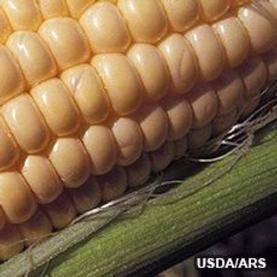
Study Linking Genetically Modified Corn
to Rat Tumors Is Retracted
Publisher withdraws paper despite authors' objections, citing weak evidence
Nov 29, 2013 By Barbara Casassus and Nature magazine

USDA
Bowing to scientists' near-universal scorn, the journal Food and Chemical Toxicology today fulfilled its threat to retract a controversial paper claiming that a genetically modified (GM) maize causes serious disease in rats, after the authors refused to withdraw it.
The paper, from a research group led by Gilles-Eric Séralini, a molecular biologist at the University of Caen, France, and published in 2012, showed “no evidence of fraud or intentional misrepresentation of the data,” said a statement from Elsevier, which publishes the journal. But the small number and type of animals used in the study mean that “no definitive conclusions can be reached.” The known high incidence of tumors in the Sprague–Dawley strain of rat ”cannot be excluded as the cause of the higher mortality and incidence observed in the treated groups,” it added.
Today’s move came as no surprise. Earlier this month, the journal’s editor-in-chief Wallace Hayes threatened retraction if Séralini refused to withdraw the paper. Hayes announced the retraction at a press conference in Brussels this morning. Séralini and his team stand by their results, and allege that the retraction derives from the journal's editorial appointment of biologist Richard Goodman, who previously worked for biotechnology giant Monsanto for seven years.
Goodman however denies any involvement in the decision to retract the paper. "Food and Chemical Toxicology asked me to become an associate editor in January 2013 because of my extensive experience in the area, and after I complained about the Séralini study,” he says. “I am paid a small honorarium for handling manuscripts about biotechnology on a part-time basis, after hours. But I did not review the data in the Séralini study, nor did I have anything to do with the determination that the paper should be withdrawn from or retained by the journal. “The magazine reviewed our paper more than any other,” says co-author and physician Joël Spiroux de Vendômois, who is also president of the Paris-based Committee for Research and Independent Information on Genetic Engineering (CRIIGEN), which collaborated in the study. The retraction is “a public-health scandal," he says.
The study found that rats fed for two years with Monsanto’s glyphosate-resistant NK603 maize (corn) developed many more tumors and died earlier than controls. It also found that the rats developed tumors when glyphosate (Roundup), the herbicide used with GM maize, was added to their drinking water. (See "Rat study sparks GM furore").
At the November 28 press conference, Corinne Lepage, a Member of the European Parliament and former French environment minister, said that Séralini’s paper asked “good questions about the long-term toxicity of GMOs [GM organisms] and the Roundup herbicide.” Retraction of the paper “will not make these questions disappear," added Lepage, who is also a co-founder of CRIIGEN.
Alleged conflicts of interest are at the center of the latest round of controversy. Lepage called for the resignation of Anne Glover, who was appointed chief scientific adviser to the European Commission two years ago and whom Lepage says is an advocate of GMOs. Since then, Lepage noted, the commission has proposed, for the first time since 1996, to authorize cultivation of GM maize in Europe. Conflicts of interest with the European Food Safety Authority (EFSA) in Parma, Italy, which is responsible for assessing the risks of GMOs, “remain numerous,” she added.
The paper’s retraction was the latest in a series of setbacks for Séralini and his group. The publication of his team's study was greeted by a storm of protest from scientists, and both the EFSA and Germany’s Federal Institute for Risk Assessment In Berlin slammed the paper for providing inadequate data to support its conclusions.
This article is reproduced with permission from the magazine Nature. The article was first published on November 28, 2013.